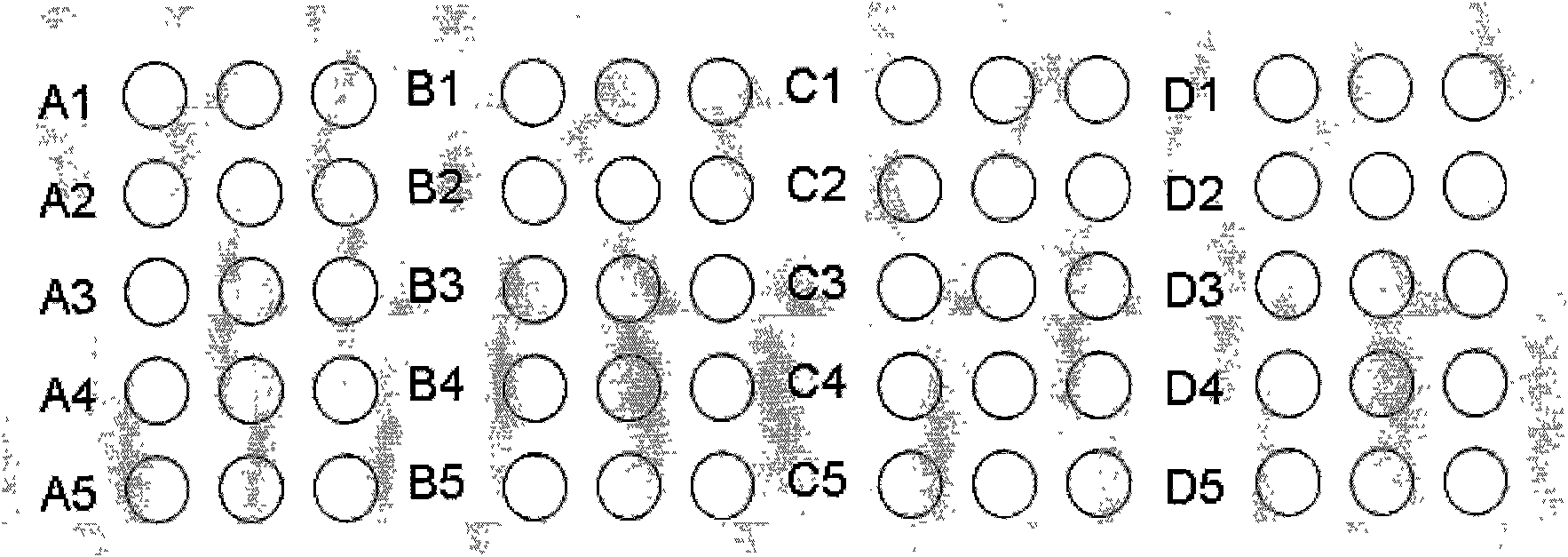Method for detecting animal pathogenic microorganisms and special protein chip thereof
A pathogenic microorganism and protein chip technology, which is applied in the detection method of animal pathogenic microorganisms and its special protein chip field, can solve the problems of poor detection effect, difficult protein purification, easy inactivation, etc., achieve good application prospects, improve detection efficiency, The effect of saving testing cost
- Summary
- Abstract
- Description
- Claims
- Application Information
AI Technical Summary
Problems solved by technology
Method used
Image
Examples
Embodiment 1
[0019] Preparation of Microbial Protein Antigen Chips
[0020] Select four of the bacteria that must be excluded in the national standard (GB14922.2-2001) for specific pathogen-free (SPF) grade mice: Salmonella Typhimurium, Pasteurella pneumotropica, Pseudomonas tuberculosis Yersinia pseudotuberculosis, Streptobacillus moniliformis. Through multiple western blot experiments, 5 specific antigens were selected for each bacterium, and these antigens were prepared by bacterial lysis, ion exchange chromatography, SDS-PAGE gel recovery electrophoresis and other methods, a total of 20 kinds. After the antigen was properly diluted with phosphate buffered saline (PBS, pH 7.4), the antigen was spotted on the aminated glass slide with the AD3200 chip spotting instrument of BioDot Company, and each antigen was spotted three times, and then the spot The good protein chip was placed in a wet box overnight at 4°C; the next day, the chip was placed in a wet box to equilibrate at room tempera...
Embodiment 2
[0022] Serological detection of mice infected with Salmonella Typhimurium
[0023] The mouse serum infected with Salmonella typhimurium was diluted with 0.5% bovine serum albumin component V-PBS (BSA-PBS) at a volume ratio of 1:100, hybridized with the microbial protein antigen chip prepared in Example 1, and incubated at 37°C for 1h , and then wash the chip with PBS 3 times, 3min / time, to wash away unbound antibodies. Then hybridize the chip with the labeled secondary antibody, the labeled secondary antibody is horseradish peroxidase-labeled goat anti-mouse IgG diluted with PBS at a volume ratio of 1:200, incubated at 37°C for 1 h, and then washed with PBS Chip 3 times, 3min / time. Finally, the chip was developed with 3,3-diaminobenzidine (DAB), dehydrated, and sealed. A microarray scanner was used to scan the color development results of the chip, and software was used to analyze the scanning results. The results showed that Salmonella typhi antigens all produced strong po...
Embodiment 3
[0025] Serological detection of mice infected with Pasteurella pneumotropica
[0026] The mouse serum infected with Pasteurella pneumophila was diluted with 0.5% BSA-PBS at a volume ratio of 1:100, and then hybridized with the microbial protein antigen chip prepared in Example 1, and the hybridization experiment was carried out according to the operation method of Example 2. The results showed that the antigens of Pasteurella pneumophila produced strong positive signals, while the antigens of other bacteria had no signals.
PUM
 Login to View More
Login to View More Abstract
Description
Claims
Application Information
 Login to View More
Login to View More - R&D
- Intellectual Property
- Life Sciences
- Materials
- Tech Scout
- Unparalleled Data Quality
- Higher Quality Content
- 60% Fewer Hallucinations
Browse by: Latest US Patents, China's latest patents, Technical Efficacy Thesaurus, Application Domain, Technology Topic, Popular Technical Reports.
© 2025 PatSnap. All rights reserved.Legal|Privacy policy|Modern Slavery Act Transparency Statement|Sitemap|About US| Contact US: help@patsnap.com

